
Balancing Customization and Speed: A CTO's Strategic Guide to Low-Code vs. Custom Software
July 23, 2025 / Bryan Reynolds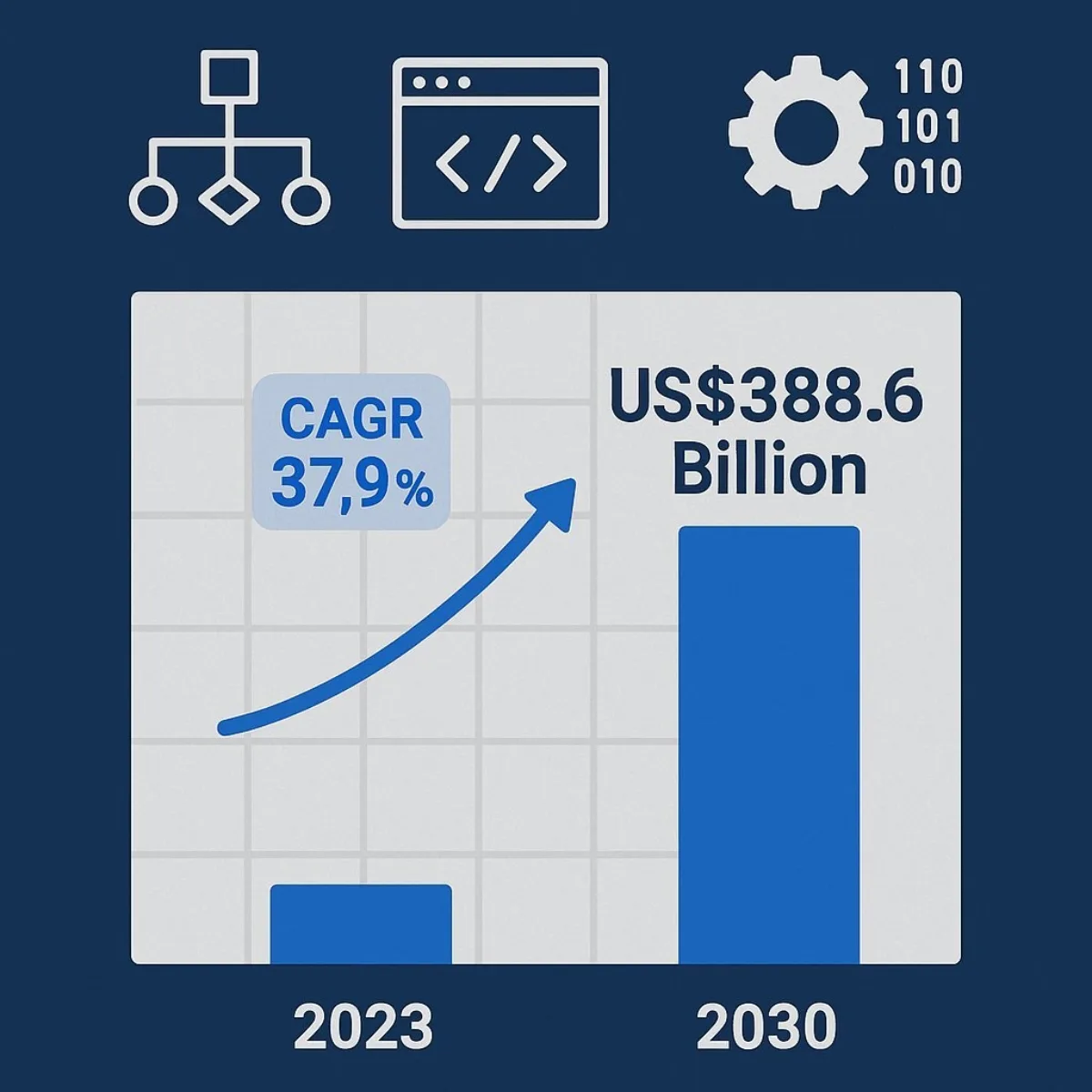
Introduction: The Modern CTO's Dilemma: Innovate Fast, Build to Last
In today's hyper-competitive digital landscape, Chief Technology Officers (CTOs) and B2B technical leaders face a fundamental conflict. There's relentless pressure from the business to accelerate innovation, deploy applications faster, and drive digital transformation initiatives. At the same time, there's a strategic imperative to build robust, secure, and scalable systems that create lasting competitive advantage and are future-proof. Navigating this tension between speed and sustainability has become the central challenge of modern technology leadership.
This challenge is amplified by the rise of the low-code development movement, a paradigm shift that is no longer a niche trend but a dominant market force. Industry analysts at Gartner forecast that the global low-code development platform market will surge to an astonishing US$388.6 billion by 2030, expanding at a compound annual growth rate (CAGR) of 37.9%. Further projections indicate that by 2025, over 70% of new applications developed by enterprises will be built using low-code or no-code technologies, a dramatic increase from less than 25% in 2023. These figures underscore the urgency and relevance of understanding this approach.
However, the decision to adopt low-code over traditional custom software development is not a simple either/or proposition. It's a nuanced, high-stakes strategic choice with profound, long-term implications for a company's budget, agility, intellectual property, and ultimate competitive standing. This guide moves beyond a simple list of pros and cons to provide a comprehensive strategic framework. It's designed to equip CTOs and technical leaders with the analytical tools, practical scenarios, and decision-making checklists needed to choose the right development path with confidence—for right now and for the future.
Section 1: Beyond the Buzzwords: The Core Philosophies of Creation
Before comparing features, it's critical to understand the fundamental philosophies that underpin each development approach. The decision between low-code and custom software is not just about how you build, but why you build. The project's strategic purpose—whether it's solving an internal efficiency problem or seizing a market opportunity—is the first and most important filter for any CTO.
The Low-Code Philosophy: Democratized Efficiency
Low-code development is best understood as a visual, model-driven approach to creating software. It operates on a core principle of abstraction, using drag-and-drop interfaces, pre-built components, and graphical modeling to hide underlying code complexity. The primary goal is to accelerate application delivery and empower a much broader group of creators, including non-technical business users often referred to as "citizen developers."
This philosophy of democratized efficiency aims to solve a persistent business problem: the bottleneck created by overburdened IT departments. By enabling business analysts, project managers, and other domain experts to build and automate their own functional applications—such as internal workflows or departmental tools—low-code platforms reduce IT backlogs and dramatically shorten time-to-market for standard business processes. In essence, low-code is a strategic response to an internal efficiency challenge, designed to optimize and streamline how a business operates.
The Custom Development Philosophy: Strategic Differentiation and Ownership
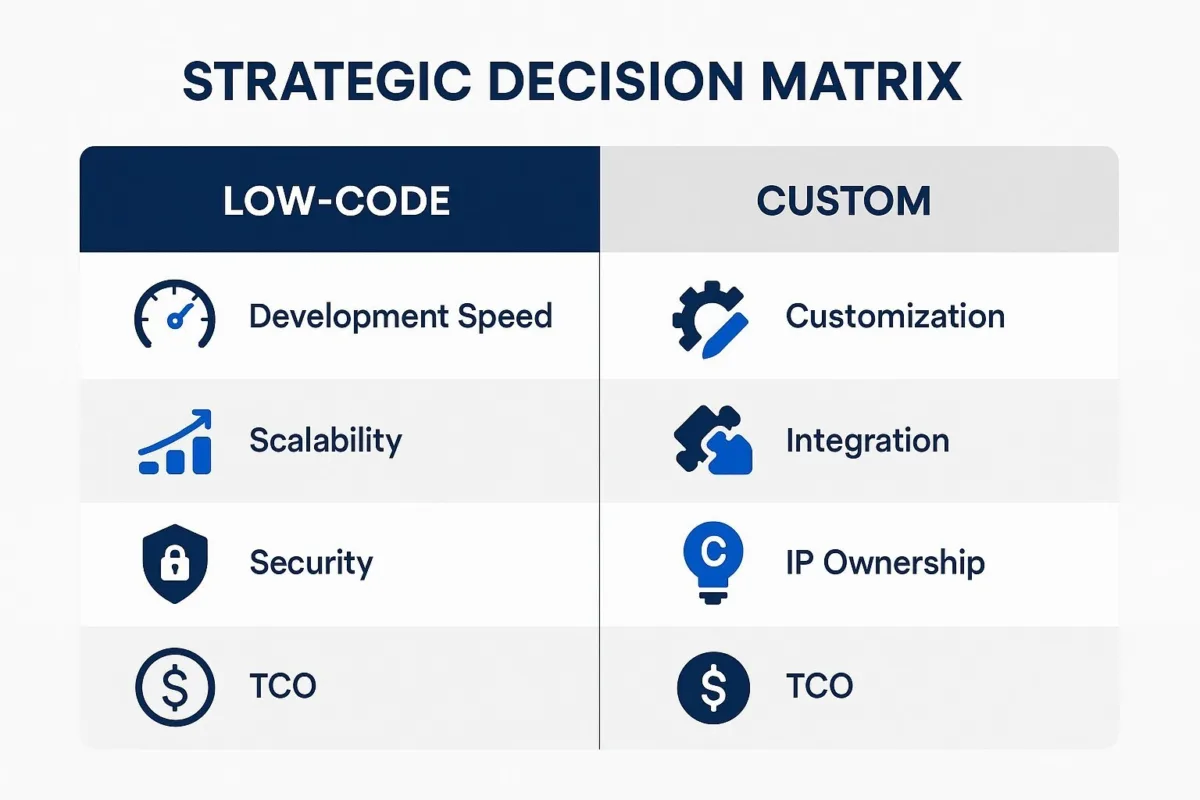
Custom software development represents a fundamentally different philosophy. It's the process of designing, creating, and implementing software from the ground up, with every line of code manually written to meet a precise set of unique business requirements. Think of it as commissioning a tailored suit rather than buying off the rack.
The primary goal of custom development is to create a strategic asset—a unique, ownable piece of intellectual property (IP) that provides a distinct and defensible competitive advantage. This path is chosen when the software
is the business or constitutes a core part of its unique value proposition to the market. It's a response to an external market opportunity, focused on creating a new product, delivering an unparalleled customer experience, or building a technological moat that competitors cannot easily replicate. The decision to build custom software is an investment in creating a revenue-generating asset, not just a cost-saving utility.
Section 2: The Strategic Decision Matrix: A Head-to-Head Analysis
For a CTO, a clear, multi-layered comparison is essential for justifying a technology investment. The following matrix provides a high-level overview of the trade-offs, followed by a deeper analysis of the most critical factors that impact long-term business outcomes.
Table 1: Low-Code vs. Custom Development: A Comparative Matrix
This table serves as a quick-reference guide, synthesizing data from across the industry to give technical leaders an at-a-glance understanding of where each approach stands on key metrics.
| Factor | Low-Code Development | Custom Software Development |
|---|---|---|
| Core Philosophy | Democratized Efficiency | Strategic Differentiation |
| Development Speed | High (Weeks/Months) | Medium-Low (Months/Years) |
| Customization & Flexibility | Medium to Low; constrained by platform | High; unlimited possibilities |
| Scalability | High for user load; potentially limited for complexity/performance | High; architected for specific growth needs |
| Integration | Strong with modern APIs; challenging with legacy/proprietary systems | High; can be built to integrate with any system |
| Security & Compliance | High (Vendor-managed, standardized); less granular control | High (Bespoke, auditable); full control for specific regulations |
| IP & Ownership | None; vendor lock-in is a significant risk | Full ownership; creates a valuable business asset |
| Total Cost of Ownership (TCO) | Low upfront, but high potential for hidden recurring costs | High upfront, but predictable and potentially lower long-term TCO |
| Required Skillset | Citizen developers, business analysts, some professional developers | Highly skilled professional developers, architects, security experts |
Deep Dive 1: Speed vs. Strategic Agility
The primary value proposition of low-code is its remarkable speed-to-market. A functional application can be developed and deployed in less than a month, sometimes in just weeks. This is a powerful advantage for businesses needing to react quickly to internal needs or test market hypotheses.
However, this initial velocity must be weighed against the concept of long-term Strategic Agility—the ability to pivot, adapt, and re-architect a core platform in response to fundamental market shifts. Custom software, while requiring a longer initial development timeline, is explicitly designed for this kind of long-term adaptability. The speed of low-code is achieved through abstraction and pre-built modules, meaning the user does not own or control the underlying architecture. If a major business model change requires functionality that the low-code vendor's platform does not support, the business is fundamentally constrained by that vendor's roadmap and capabilities. This can create long-term rigidity. In contrast, a company that owns its custom codebase can re-architect it from the ground up to pursue new opportunities, providing true strategic agility. For a CTO, the decision hinges on distinguishing between tactical speed (launching a departmental app quickly) and strategic speed (the ability to outmaneuver a competitor with a core product innovation 18 months from now).
Deep Dive 2: Upfront Cost vs. Total Cost of Ownership (TCO)
On the surface, the cost comparison seems simple. Low-code platforms often have attractive entry points, with subscription fees starting around $3,000 per month, whereas a custom application can require an upfront investment ranging from $20,000 to over $250,000. However, a CTO's budget responsibility extends far beyond the initial purchase order. The only valid financial model for this decision is Total Cost of Ownership (TCO), which accounts for all direct and indirect costs over the software's lifecycle.
The "TCO Iceberg" illustrates how the low initial cost of a low-code platform can conceal significant, recurring expenses that lie "below the surface."
Table 2: The TCO Iceberg: Low-Code vs. Custom
| Cost Component | Low-Code Development | Custom Software Development |
|---|---|---|
| Direct (Upfront) | Low platform/licensing fees | High development, design, & QA costs |
| Direct (Ongoing) | Per-user fees, subscription renewals, API call limits/overages, storage costs | Hosting/infrastructure, domain fees, 3rd party library licenses |
| Indirect (Hidden) | Integration consulting, customization workarounds, vendor support packages, training/onboarding time, security audit fees | In-house or outsourced maintenance & support team, user training, documentation |
| Strategic Costs | Vendor lock-in (migration is a full rebuild), potential performance/scaling penalties | Technical debt management, full responsibility for security/updates |
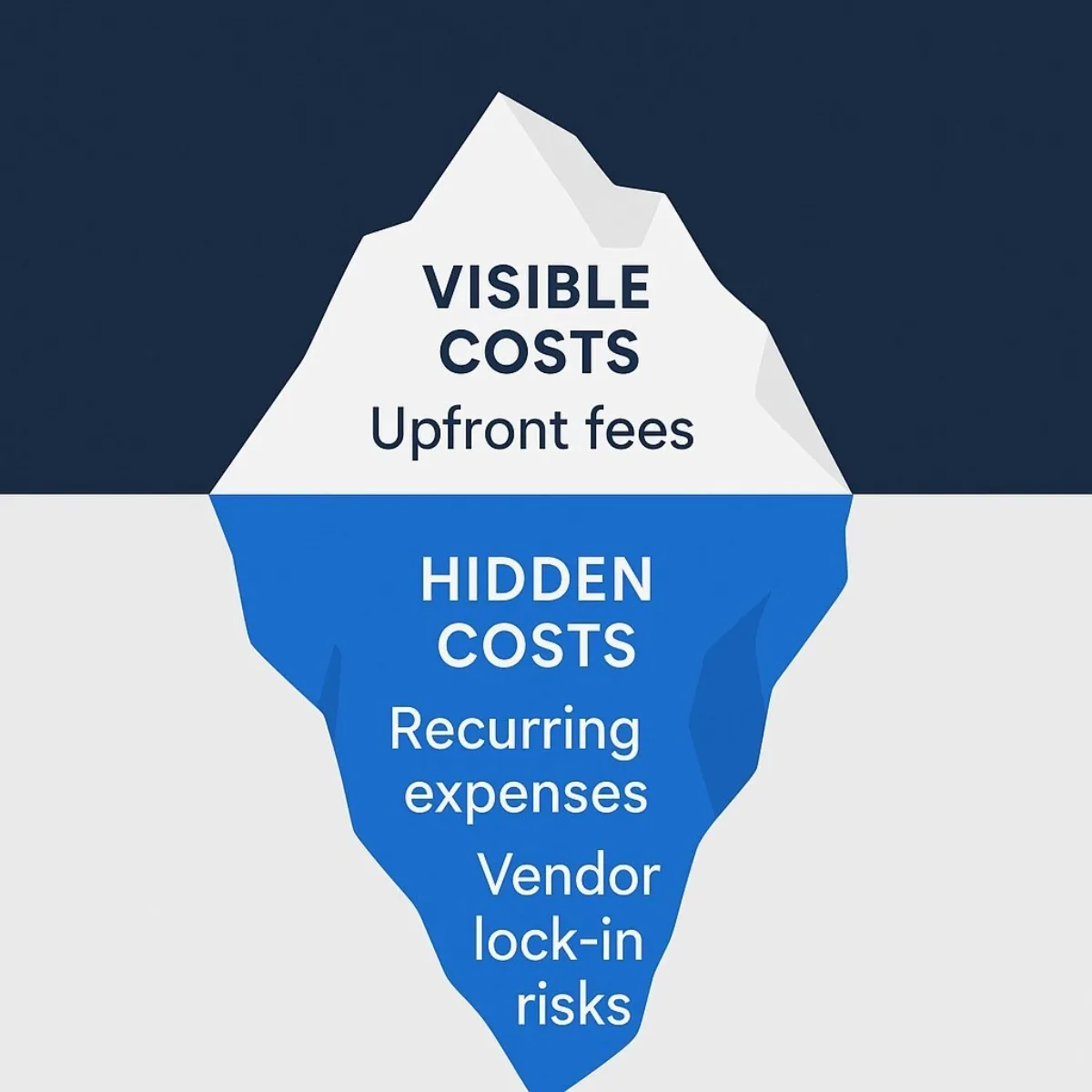
A critical hidden factor is the scalability cost trap. Low-code vendors often structure their pricing in tiers based on usage metrics like the number of users, API calls, or data transfer volumes. As a successful application grows, the business can be forced into exponentially more expensive tiers, leading to unpredictable and potentially unsustainable costs. A custom solution, while more expensive to build initially, typically runs on commodity cloud infrastructure where scaling costs are more linear, predictable, and controllable. A CTO must therefore model projected growth against the vendor's pricing structure to avoid a situation where a solution that's affordable for 100 users becomes financially crippling at 10,000 users.
Deep Dive 3: Vendor Ecosystem vs. Intellectual Property (IP)
Low-code platforms offer the convenience of a managed ecosystem. The vendor handles server maintenance, platform updates, and routine security patching, freeing the internal IT team from these operational burdens.
The strategic price for this convenience is vendor lock-in. The application's logic, data structures, and core functionality are inextricably tied to the vendor's proprietary platform. Migrating to another platform or to a custom solution is not a simple export-import process; it requires a complete rebuild from scratch, which can be prohibitively expensive and complex.
Custom development offers the opposite proposition. The business assumes full responsibility for maintenance and updates but, in return, gains complete ownership and control over the source code. This codebase is not just a tool; it's a tangible, valuable piece of intellectual property that can be listed as a company asset, leveraged for future projects, and evolved without any external dependencies.
Deep Dive 4: Standard Security vs. Bespoke Fortification
Leading low-code platforms provide robust, enterprise-grade security features out of the box. They often come with certifications like ISO 27001 and SOC 2, and include standard tools like role-based access control (RBAC) and multi-factor authentication (MFA). A well-governed low-code platform can be significantly more secure than a poorly written custom application.
However, for businesses operating in highly regulated industries such as finance or healthcare, this standardized security can be a "black box". It may not offer the granular control, specific encryption standards, or detailed audit trails required to prove compliance with strict mandates like the Health Insurance Portability and Accountability Act (HIPAA) or the Payment Card Industry Data Security Standard (PCI DSS). Custom development enables a security-by-design methodology. This approach allows for the creation of a bespoke security architecture where specific controls, data handling policies, and auditable logging mechanisms are woven into the software from the very first line of code, ensuring full compliance and legal defensibility.
Section 3: The Litmus Test: Practical Scenarios for B2B Leaders
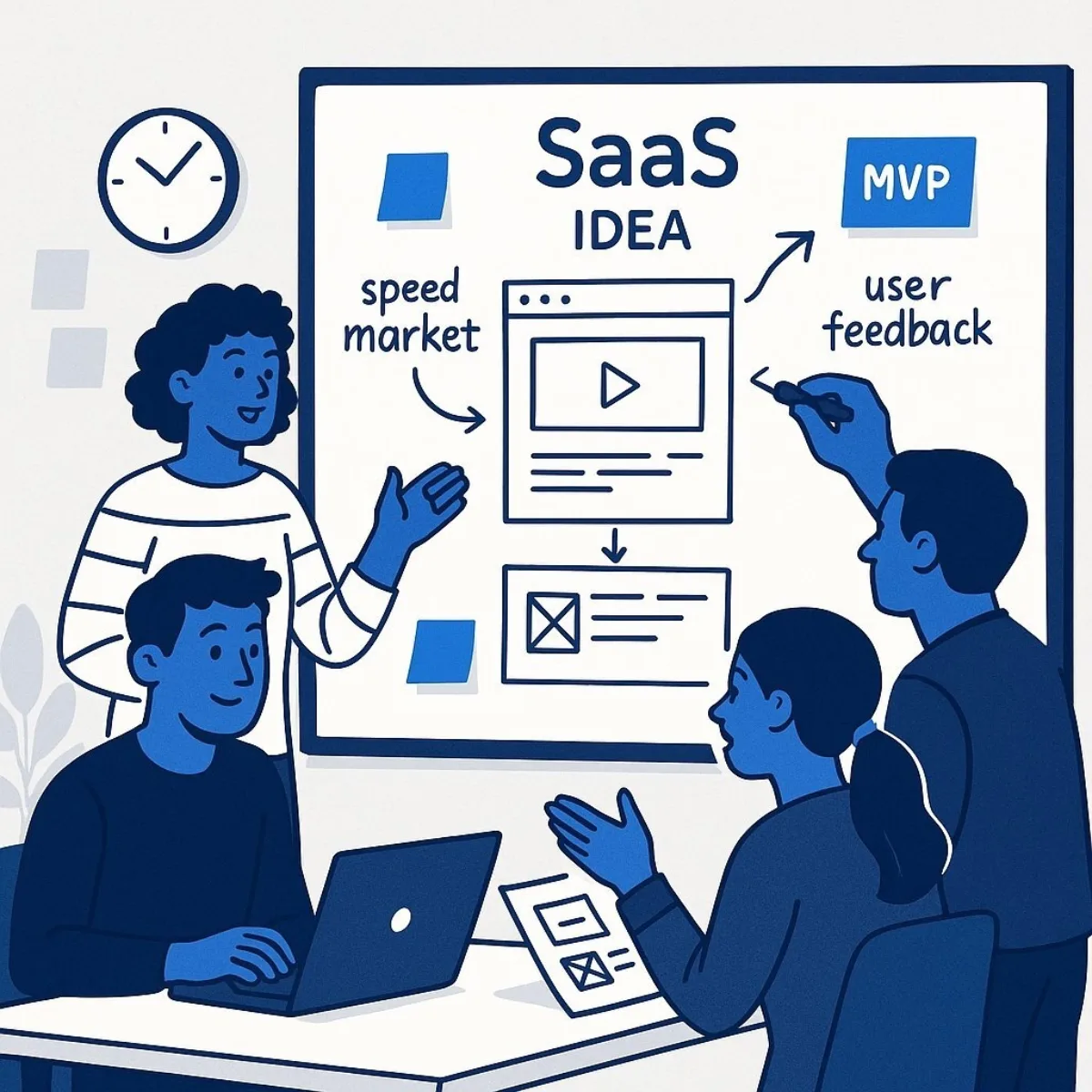
To move from theory to practice, consider these four common scenarios faced by B2B technology leaders. Each illustrates how the strategic framework leads to a clear decision.
Scenario 1: The MVP Launch - "Fail Fast, Learn Faster"
- Business Need: A B2B startup has a novel idea for a SaaS product but needs to validate its core value proposition with real users before committing to a full development cycle and seeking Series A funding. The timeline is three months, and the budget is extremely limited.
- Analysis: The primary objective here is speed-to-market and gathering user feedback, not building a scalable, feature-rich platform. The greatest risk is not vendor lock-in, but building the wrong product entirely with a significant upfront investment.
- Verdict: Low-Code. This is a clear win for low-code. Platforms such as Bubble, Glide, or Webflow are ideal for rapidly building a Minimum Viable Product (MVP) that can be put in front of early adopters to test assumptions. The historical examples of companies like Zappos, which started with a "Wizard of Oz" MVP by manually fulfilling orders from a basic website, and Dropbox, which validated its idea with a simple explainer video, highlight the principle of minimizing initial investment to maximize learning.
Scenario 2: The Departmental Efficiency Play - "Automating Internal Workflows"
- Business Need: The HR department of a mid-sized manufacturing firm wants to digitize its cumbersome, paper-based employee onboarding process. The goal is to automate tasks like creating user accounts, distributing policy documents, and scheduling orientation sessions.
- Analysis: This is a classic internal process automation use case. The workflow is standardized, well-understood, and not a source of competitive differentiation. The application will be used internally by a limited number of employees.
- Verdict: Low-Code. Low-code platforms like Microsoft Power Apps, Kissflow, or ServiceNow are purpose-built for these scenarios. They empower "citizen developers" within the HR department to build, manage, and iterate on the workflow with minimal direct involvement from the core IT team. Case studies from companies like Puma Energy, which built hundreds of internal applications, and Valantic, which used low-code to reduce its IT backlog, demonstrate the power of this approach for enhancing operational agility.
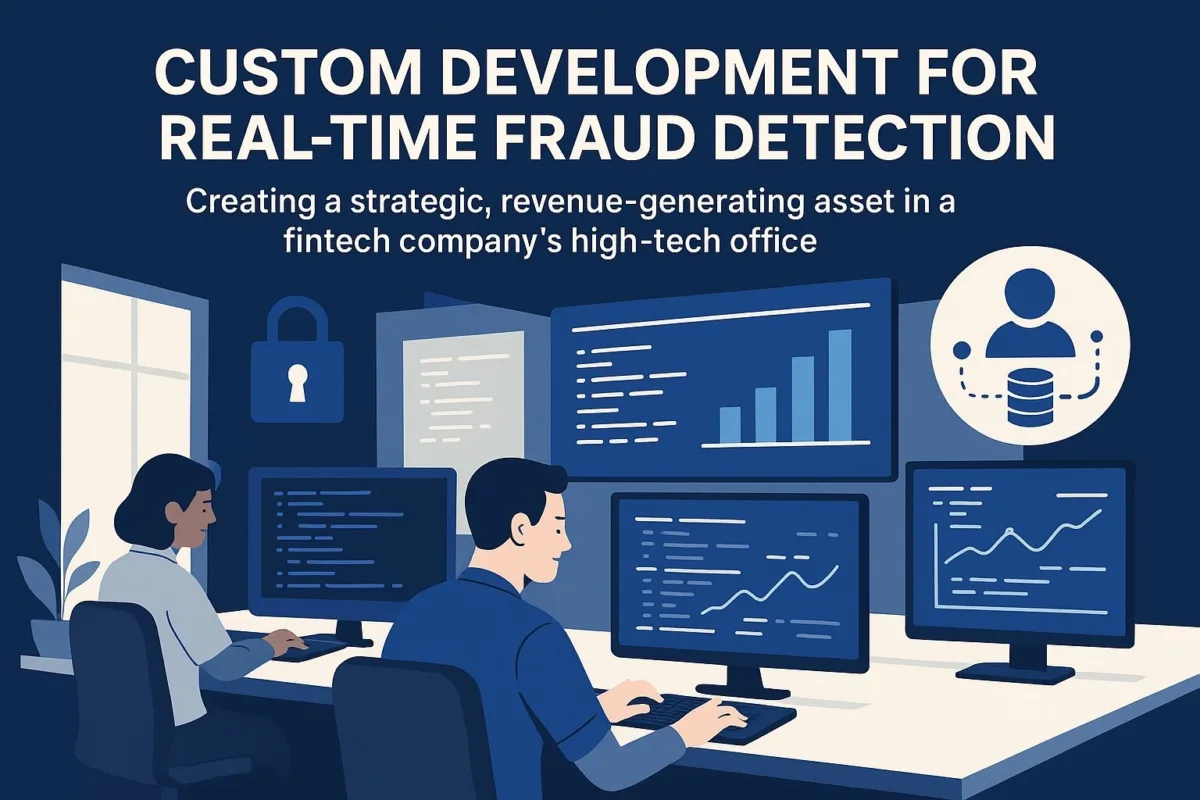
Scenario 3: The Core Product Engine - "Building the Crown Jewels"
- Business Need: A fintech company's entire business is built on a proprietary platform that uses complex, custom algorithms for real-time fraud detection and risk assessment in high-volume transactions. This platform is their primary revenue driver and their key intellectual property.
- Analysis: This application is the definition of a mission-critical, core business system. It demands high performance, extreme security, full IP ownership, and the ability to integrate with complex, real-time financial data feeds. The core logic is unique and cannot be replicated with pre-built modules. Strict regulatory compliance (e.g., PCI DSS, GDPR) is non-negotiable.
- Verdict: Custom Development. This is an unequivocal case for custom software. Entrusting the company's "crown jewels" to a third-party platform would introduce an unacceptable level of strategic risk. The software is the business. Case studies from industries like finance, healthcare, and high-performance computing consistently show that when complexity, unique IP, and stringent security are paramount, custom development is the only viable path.
Scenario 4: The Hybrid Power Move - "The Best of Both Worlds"
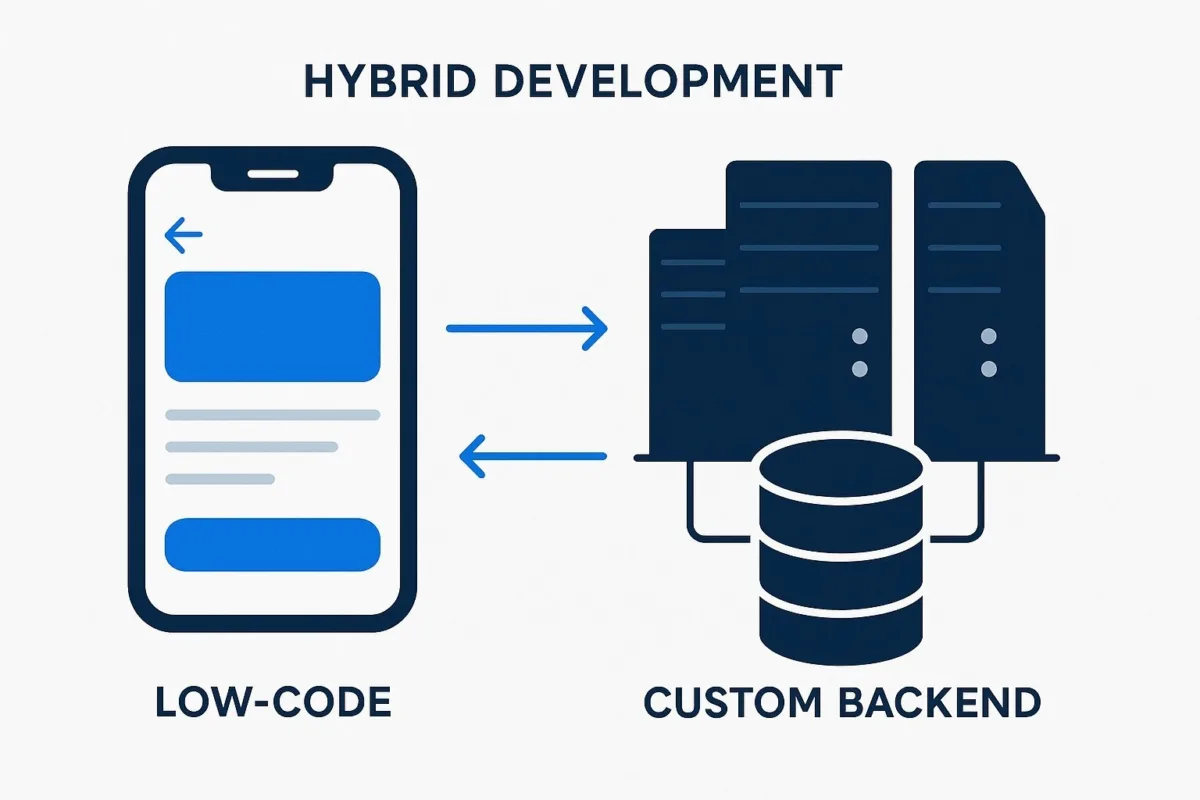
Business Need: A large insurance provider wants to modernize its claims processing system. They need a sleek, user-friendly mobile app for customers to submit claims and upload photos (the front-end). However, this app must connect to a powerful, secure backend that can process the claims, run complex validation rules, apply proprietary fraud detection algorithms, and—most critically—integrate with a 20-year-old legacy mainframe system.
- Analysis: A pure low-code approach would excel at building the front-end mobile app but would likely fail at the complex backend logic and, especially, the deep integration with the antiquated legacy system. A full custom build for the entire stack might be unnecessarily slow and costly, especially for the standard UI components.
- Verdict: Hybrid. This scenario is a prime candidate for a composable, hybrid architecture that leverages the strengths of both approaches. The strategy is to use a low-code platform to rapidly develop the customer-facing UI and simple data submission workflow. This front-end then communicates via secure APIs with a custom-built, microservices-based backend. This custom backend is designed specifically to handle the heavy lifting: the complex business logic, the proprietary fraud detection engine, and the challenging integration with the legacy mainframe. A real-world example of this strategy is a fintech startup using low-code for its standardized customer onboarding workflows while running its unique core banking engine on custom code. This approach not only supports seamless integration but also maximizes value from both development models.
Section 4: The CTO's Go/No-Go Checklist
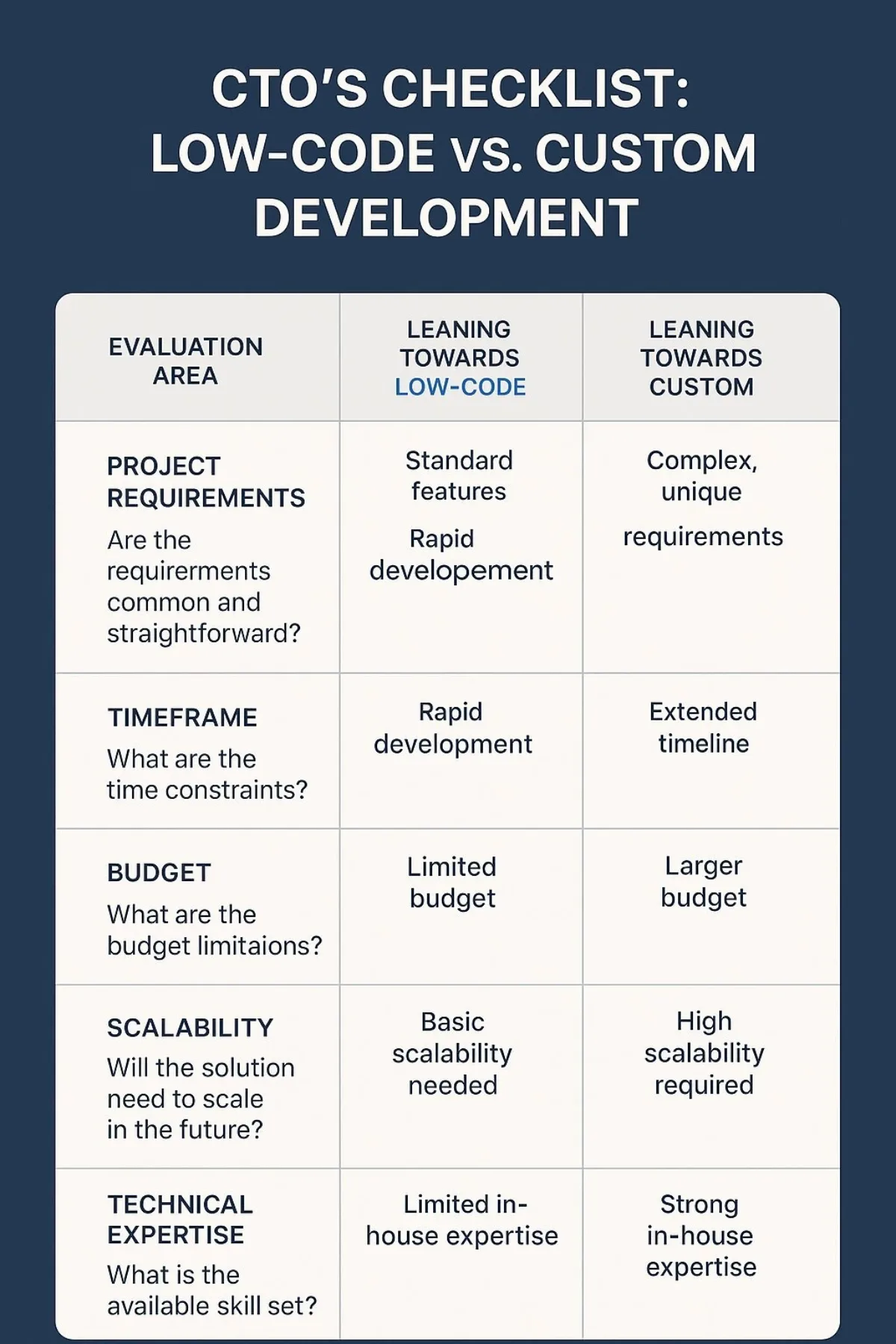
To aid in the decision-making process during project planning, this checklist provides a structured framework for evaluating a project's requirements against the capabilities of each approach. It's designed to be a practical tool for a CTO to use in kickoff meetings, guiding the conversation from tactical needs to strategic implications.
Table 3: The Low-Code vs. Custom Development Decision Checklist
| Evaluation Area | Key Question | Lean Towards Low-Code If... | Lean Towards Custom If... |
|---|---|---|---|
| 1. Strategic Value | Is this a core competitive differentiator or a supporting utility? | It's a supporting utility (e.g., internal workflow, standard business function). | It's a core product, contains proprietary IP, or is a key market differentiator. |
| 2. Complexity & Customization | How unique are the business logic and workflow requirements? | The process is standardized and can be built with pre-existing components. | The logic is highly complex, unique, or requires functionality not available in platforms. |
| 3. Integration | What systems must this application connect to? | It needs to connect to modern SaaS apps with standard APIs. | It requires deep integration with legacy systems, proprietary databases, or complex APIs. |
| 4. Scalability & Performance | What are the 5-year projections for user load, data volume, and transaction complexity? | User growth is the main scaling factor; performance needs are standard. | High transaction volumes, real-time processing, or complex computations are required. |
| 5. Security & Compliance | What are the specific data security and regulatory requirements? | Standard security (SOC2, etc.) is sufficient; no complex compliance needs. | It must adhere to strict, auditable regulations (HIPAA, PCI DSS, GDPR). |
| 6. IP & Ownership | How critical is it for the business to own the source code and control the roadmap? | Vendor dependency is an acceptable risk; the app is not a long-term strategic asset. | Owning the IP is a strategic imperative; you need full control over the asset's future. |
| 7. Budget & Timeline | What are the immediate constraints on budget and time-to-market? | Speed is the top priority, and the upfront budget is limited. | The long-term ROI is more important than the initial cost/timeline; this is a strategic investment. |
Section 5: From Code to Competitive Edge: The Role of a Strategic Development Partner
If the answers to the checklist consistently point towards the "Custom" column, the challenge for a CTO shifts from what to build to how to build it successfully. The traditional narrative of custom development is often fraught with concerns about long timelines, budget overruns, and project risk. This is where the role of a strategic development partner becomes critical. A firm like Baytech Consulting is positioned not merely as a vendor that writes code, but as a partner that mitigates these risks and ensures the custom project delivers on its strategic promise.
The value proposition of a premier custom development firm directly addresses the inherent challenges of building bespoke software:
- Architectural Foresight: An expert partner does not simply build to a static set of requirements; they design for the future. Baytech Consulting brings deep expertise in creating scalable, flexible, and maintainable architectures. This foresight helps prevent the accumulation of technical debt and ensures the final product can evolve and grow with the business, a crucial element for long-term ROI.
- Agile Deployment for Custom Projects: To counter the perception that custom development is slow, firms like Baytech employ an agile methodology. By delivering functional software in iterative sprints, they provide tangible value quickly, allow for continuous feedback from stakeholders, and ensure the project remains tightly aligned with business objectives. This approach blends the iterative speed of agile with the strategic power of custom, directly addressing the core tension of this guide.
- Deep Security & Compliance Expertise: For any business handling sensitive data or operating in a regulated industry, security cannot be an outsourced or standardized function. A strategic partner provides the specialized expertise to build a fortified, compliant solution from the ground up. This includes implementing industry-specific security protocols and ensuring the application architecture is fully auditable and defensible, a critical service for any CTO.
- Seamless Integration Mastery: One of the most common failure points for complex software projects is integration, especially with legacy systems or a diverse technology stack. An experienced partner like Baytech has the mastery to navigate these challenges, engineering the custom connectors and APIs needed for seamless data flow—a capability that is often a significant limitation of low-code platforms. To see how strategic integration can be a true differentiator, explore this analysis of integration talent and approaches.
Ultimately, Baytech Consulting embodies the philosophy of strategic differentiation. They are the partner that enables a business to translate a unique vision into a tangible, ownable, and secure digital asset—the kind of asset that builds a lasting competitive advantage.
Conclusion: Making the Right Choice for Right Now—and for the Future
The modern technology landscape demands a sophisticated approach to application development. The choice between low-code and custom software is not a battle of good versus bad, but a strategic decision about deploying the right tool for the right job.
Low-code platforms have rightfully earned their place as a powerful force in the enterprise. They are an invaluable tool for accelerating internal efficiency, empowering non-technical teams, and rapidly testing new ideas with minimal risk. For standardized workflows and non-core applications, low-code offers an unparalleled combination of speed and accessibility.
However, when an application is the core of the business—the source of its unique value, the keeper of its sensitive data, the engine of its competitive advantage—custom development becomes non-negotiable. It is a strategic investment in ownership, control, and long-term agility. The smartest enterprises today are not choosing one approach over the other; they're building a hybrid strategy, playing chess, not checkers. They deploy low-code where speed is the key driver and invest in custom software when building a powerful, defensible market position is the ultimate goal, especially in a world where AI is transforming the software creation process.
This guide has provided a framework to help navigate that decision. When business needs are standard and the goal is efficiency, a low-code platform can be the fastest path to value. But when the ambition is to lead, to differentiate, and to build a lasting digital asset that will scale with the business for years to come, a strategic development partner is essential.
About Baytech
At Baytech Consulting, we specialize in guiding businesses through this process, helping you build scalable, efficient, and high-performing software that evolves with your needs. Our MVP first approach helps our clients minimize upfront costs and maximize ROI. Ready to take the next step in your software development journey? Contact us today to learn how we can help you achieve your goals with a phased development approach.
About the Author

Bryan Reynolds is an accomplished technology executive with more than 25 years of experience leading innovation in the software industry. As the CEO and founder of Baytech Consulting, he has built a reputation for delivering custom software solutions that help businesses streamline operations, enhance customer experiences, and drive growth.
Bryan’s expertise spans custom software development, cloud infrastructure, artificial intelligence, and strategic business consulting, making him a trusted advisor and thought leader across a wide range of industries.


